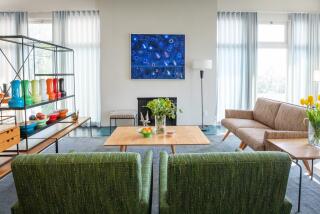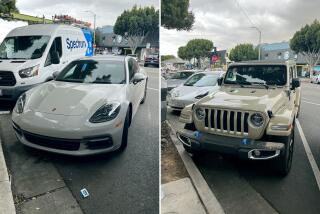This Porsche is still driven
- Share via
Ferdinand Alexander Porsche, the man who designed the iconic Porsche 911 and then left the auto industry to begin an industrial design house, is back -- as lead design consultant for the 2003 Porsche Cayenne.
But the dapper 66-year-old, namesake and grandson of Porsche AG founder Ferdinand A. Porsche, is not back in the car business full time. He says he prefers being able to use his skills on a variety of projects -- a luxury that running his own firm, Porsche Design, permits.
Besides, he says in rapid German, he needs constant activity to feel alive, “and you can’t design a new car every day.”
In an exclusive interview with The Times during his first visit to the U.S. in 20 years, Porsche said his aim as a designer always has been to reduce objects to their essential function and then use appropriate advanced materials to achieve a form that makes the function come alive.
With Mark, his youngest son, translating, he said he preferred combining hand craftsmanship with high-technology materials.
“In good design you have to combine different fields,” he said, holding out a hefty stainless steel pen from the Porsche Design collection. “In this, the material [on the barrel] is very different. It comes from high-pressure automotive hose that is very elastic. It is by combining the different parts that we can create something unique.... See, this automotive material compresses and creates the same function [of exposing or hiding the pen’s tip] in a more habitable way.”
The fact that he chose an automotive component for the pen’s body isn’t a coincidence. “I never am far from the auto industry,” he said with a laugh.
The headquarters of Porsche Design is in Austria’s Salzburg Mountains, in the town of Zell am See, where Porsche has worked for 30 years with an international team of designers and technicians on projects ranging from motorcycles and hospital incubators to televisions and computers.
It was the launch of a laptop computer that brought Porsche to the Porsche Design Boutique on Beverly Hills’ posh Rodeo Drive late last month.
There, sitting at a polished mahogany table in an upstairs conference room, he talked about the role of the designer in society, defended the idea of a sport utility vehicle from a premier performance sports car maker and said he didn’t see much progressive thinking in automotive design today.
Question: You left Porsche’s design studio in 1972 to start your own industrial design firm. But your family still owns controlling interest in Porsche, so you haven’t walked away altogether. How much do you keep involved with the car design side?
Answer: Practically every time I am in Stuttgart, I visit the [Porsche AG] studio, and I offer suggestions when asked. But the car I’ve been most involved in [since 1972] was the Cayenne.
Q: Why that? You are known as the father of the 911, a performance car. How do you go from that to an SUV?
A: Well, the 911 has many evolutionary changes, but all 911s are in the same family. The Cayenne is a completely different car, so it was more of a challenge. And they asked me to come back.
Q: Most automotive marques have undergone massive changes in styling over the decades. It would be difficult to look at a 1940 Cadillac and a 2002 Cadillac if their badges were stripped and tell they are from the same line. But Porsches all have a distinct family resemblance. Why?
A: You have to keep the identity. If there are technical developments, then you have to incorporate the shape to the new technology, but a Porsche will always look like a Porsche. My grandfather took these shapes from nature, so the headlamps of the 911 maybe look a little like the eyes of the frog, but it comes from nature, and the best shapes are from nature, so why change?
Q: We talk about design and we talk about engineering. Do the two ever mesh, or are they always at war with one another?
A: No. Designers need to be part engineer. Good design only exists in concert with engineering. That is because form has to follow function, so you focus on function and then give the object a shape to make it appealing.
Q: Your thoughts about the state of auto design: Are we seeing a renaissance after the econo-boxes of the ‘70s and the jellybean shapes of the late ‘80s?
A: Automotive design today lacks individuality. It is all melting together, and the different brands are copying each other. And also, they are all trying to go back into their own history. When you look at the BMW, how do you say, zed 8 [the Z-8 roadster], you see it is a retro design. It is nice to go with your roots, but it seems that it is a lack of creativity that forces them to do this. They go back because they don’t know where to go forward.
Q: Ouch. Let’s look at Porsche again. Some say design reflects our emotional state and that the proliferation of SUVs, which are based on old military vehicles, says we no longer are fancy-free but are afraid and seeking vehicles that surround us in safety, like a tank. Is that what the Cayenne is all about?
A: Well, off-road cars are strong cars, but the trend to SUVs is based more on the feeling of freedom [than fear], on the feeling that our urban society is fed up with urban surroundings. People want the feeling that we can go across country whenever we want.
Q: Is that what you were trying to say with the Cayenne?
A: It was important to focus on the aspect that it is a real off-road car, able to go where the Land Rover Defender could go, and on the other hand is a luxury limousine you could take to the opera. And, of course, it still is a Porsche.
Q: The name doesn’t seem to say much about function.
A: The name was picked by the company, and I’m sure it is interesting why it was picked, but I could never figure out why.
Q: You’ve been a designer for more than 40 years. You say that auto design today seems to be going backward. Has it all been said and done?
A: Not at all. I was recently approached to redesign a grand piano. That’s interesting to me, because in earlier times we would all agree that a piano was made of wood because of the resonance. But now we have new materials and we have the possibility to redesign a classic object to give it new shape. That is a challenge. There are still a lot of possibilities to improve design.






